|
|
TRANSPORT TOKENS FROM AROUND THE WORLD
with thanks to Curtis Judge and Yosef Sa'ar
Click on image for a larger version
Nanchang Metro, China
Nanchang Metro, Jiangxi Province, China. first opened in December, 2015. Single Journey Ticket.

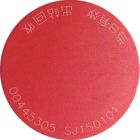
New York City Transit System - NY 998 N
New York City Transit System NY 998 N. This rare one is offered on a popular internet auction site. It was US$19,999.99, but has been reduced to $5,000..
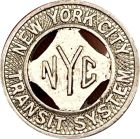
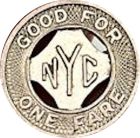
Griffin Motor Coaches – One Fare Token – Georgia GA 450-A
Griffin Motor Coach Company was based in Griffin, Georgia, a small city located approximately 50 miles south of Atlanta. It operated in the 1940-50’s providing local and school bus service to the city. Several routes were also offered to Atlanta. The company used three different tokens during its operations, two general one fare and a student variety.
Shown below is one of the general fare token listed as GA 450-A in the Atwood Coffee transit catalog. It was minted in 1945 with a total of 37,000 pieces being produced in brass. A large quantity of the company’s tokens were white metal plated by a private party for speculative purposes after the company stopped using tokens. These plated tokens were not official issues and are not worth any premium other than as a curiosity.
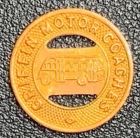
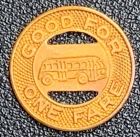
Carpenter’s Rapid Transit – One 10 Cent Fare – Corning, NY 150-B
Carpenter’s Rapid Transit, owned by Norman J. Carpenter, was operating 16 buses over 47 route miles in 1945. The company serviced Corning, Riverside and Painted Post New York on a local basis. They also ran intercity routes between Corning, Elmira and Waverly. The company began operating in 1938 and went out of business in 1958.
Carpenters issued two different 10 cent fare tokens during its operations. The example shown below is listed in the Atwood-Coffee transit catalog as New York 150-B. 65,000 pieces of the white metal token were minted in 1938. Two minor die varieties are known. A second token using the same dies was minted in zinc metal. A quantity of 45,000 was struck in 1943 and cataloged as 150-A.
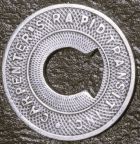
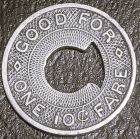
Erfurt Germany – War Time Fiber Fare Token – DEU 315 AA
On 13 May 1883, the first horse tram line started operation, run by the Erfurter Straßenbahn AG.
Passenger trips grew quickly and soon, three tram routes were in operation with the designations Red, Green and Yellow.
Plans to electrify the Erfurt tram system were undertaken in 1893.
The first test drives on the electrified system were carried out on 28 May 1894, and the tram system was converted to electric current by 20 August 1894.
In 1920, the municipality of Erfurt took over the tram network and it has been operated by a governmental entity ever since.
The system continued to grow and modernize except during the world war periods, and is still operating today.
The Erfurt rail system is considered one of the best in Europe. Erfurt issued 5 different tokens good for general, student and employee fares.
The example below is a general fare token and cataloged as DEU 315-AA in Smiths 1990 transit catalog.
The token was a war time issue and manufactured using a fiber disk rather than a metal blank. All metals were on war time allocation for armament production.
The token is 24mm in diameter struck on a redish brown fiber material with black ink wording.
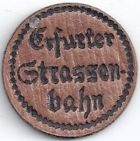
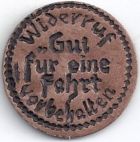
British Columbia Electric Railway Co. – Employee Transit Pass
The British Columbia Electric Railway (BCER) was an historic railway which operated in southwestern British Columbia, Canada. Originally the parent company for, and later a division of, BC Electric Company (now BC Hydro). The BCER assumed control of existing streetcar and interurban trolley lines in southwestern British Columbia in 1897, and operated the electric railway systems in the region until the last interurban service was discontinued in 1958. During and after the streetcar era, BC Electric also ran bus and trolleybus systems in Vancouver and bus service in Victoria; these systems subsequently became part of BC Transit, and the routes in Greater Vancouver eventually came under the control of Translink.
Like many other transit companies, BC Electric issued passes to employees allowing them to travel on the system for free. The pass shown below was issued to the BCER employee and individually numbered for identification purposes. The pass is very interesting in that it is a combination of a celluloid (yellow – black) center encased in an aluminum housing with a hole for suspension. Reverse lettering on the case indicates a $5.00 reward for return of a lost pass to the company. The pass measures 40X56mm, dates of use and quantity produced are unknown. The BCER passes are seldom seen with this example being the first known to the writer.
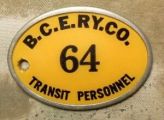
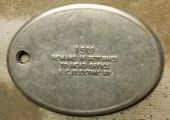
Williamsville – Buffalo Express Dual Category Civil War / Transit Token
There are numerous tokens that interest two or more diverse collector groups. The Williamsville – Buffalo Express token is one, being cataloged as a civil war token by Fuld and as a transit item listed in the Atwood catalog. In the 1860’s the Williamsville express provided daily service between the cities of Buffalo and Williamsville in western New York State. This token was issued as an advertising piece to promote ridership and detail the departure times from each location. The route was just over 13 miles long.
The token is listed in Fuld’s Civil War catalog as NY990-A-1a with a R-5 Rarity. It is also listed in the Atwood-Coffee transit catalog as Timetable “E”. The token is 19mm in diameter struck in copper with a reeded edge. The total mintage and exact dates of usage are unknown

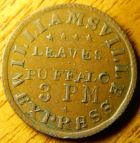
Hull Metro Transport, Quebec, Canada
Transport Hull Metro, Hull, Quebec, Canada. Consimilar, white metal, 20 millimetres. This token indicated the zone paid on the bus to Ottawa, one thru eight (1-8). Placed in use circa 1960.
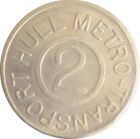
La Rochelle France Tramways – 50 Centimes Fare Token – FRA 480-AJ
Tramways De La Rochelle operated during the years of 1901-1929 providing transport in and around the city of La Rochelle. The system used a rather unique compressed air propulsion system invented by Louis Mekarski. The Mekarski system was promoted as being suitable for use in congested streets and in tunnels, as compressed air produced no smoke or flames, and thus would not disturb horses or fill the carriage with soot and sparks like a steam engine. The system proved unreliable, especially in the winter, with many drives freezing, bursting hoses and the cold causing greatly reduced travel range. The initial trams were replaced with electric operating systems after a few years.
Tramways De La Rochelle issued ten different fare tokens in various sizes, metals and denominations of 5, 10, 20 and 50 centimes. The 50 centimes example shown below is cataloged as FRA 480-AJ in Smiths transit catalog. It is 25mm across the flats and struck in brass. This example has a “TLR” counterstamp on the reverse for unknown reasons.
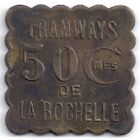
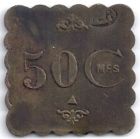
Information on Transport Tokens - Just click here
|
|
|
****** Click here to return to the Photo Gallery Menu******
|
|
 |
 |
Copyright © Redcliffe Numismatic Society Inc. 2016. Original content in these pages is copyright. Apart from any use permitted under the Copyright Act, no part may be produced by any process or other exclusive right exercised without permission of the copyright holder. Redcliffe Numismatic Society Inc. takes no responsibility for the content on external Internet sites.
Site design by Designs4u Creative Websites,
Graphic Design & Photography Solutions |
|
 |
 |
|
|

